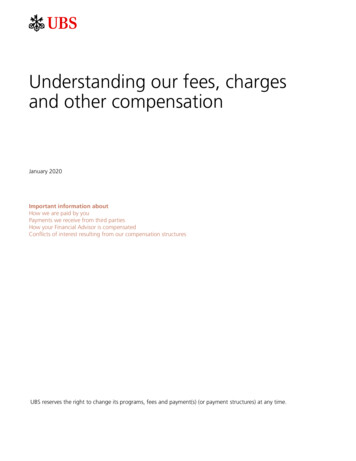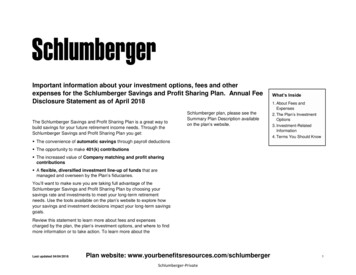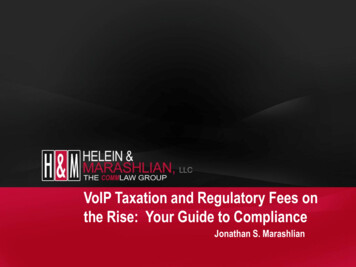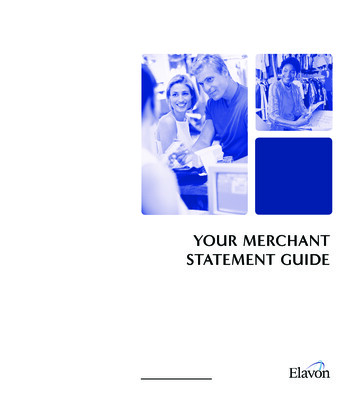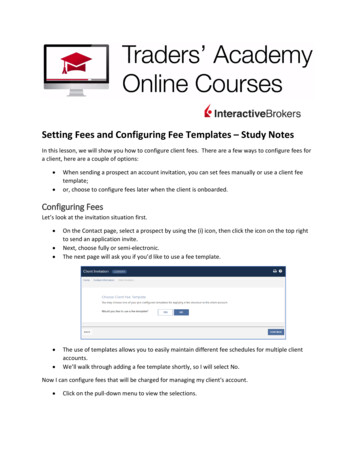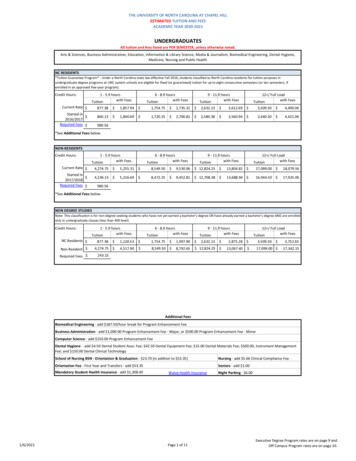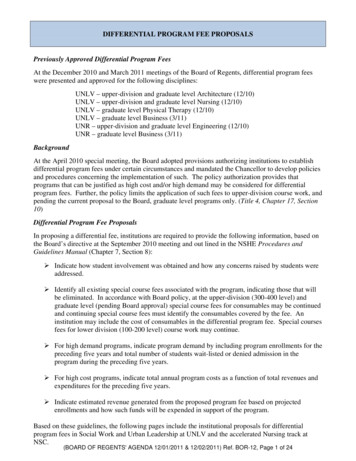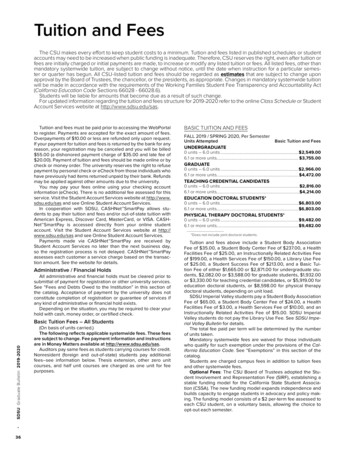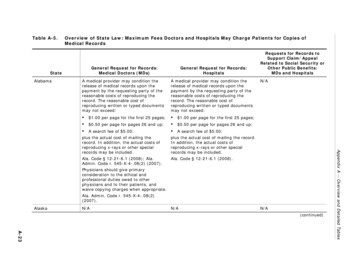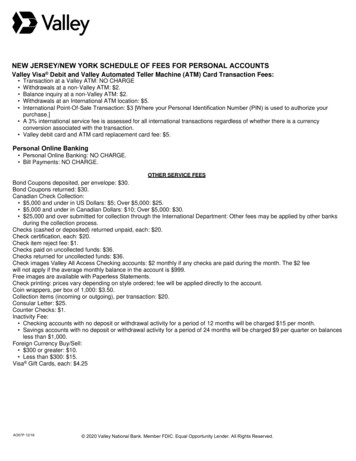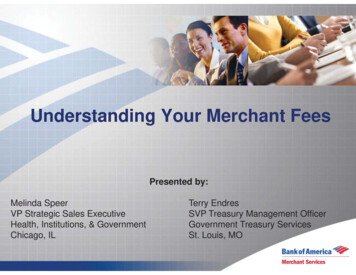
Transcription
Understanding Your Merchant FeesPresented by:Melinda SpeerVP Strategic Sales ExecutiveHealth, Institutions, & GovernmentChicago, ILTerry EndresSVP Treasury Management OfficerGovernment Treasury ServicesSt. Louis, MO
Agenda How merchant fees are determined? What is Interchange? How can you ensure the best interchange qualification? What laws/regulations control merchant processing? Should you use Convenience Fees or not?- What does this mean and what are the pros and cons? Factors to consider when doing a merchant RFP2
How Merchant Fees Are Determined? The merchant processors base their pricing on thefollowing criteria:- General Risk of the industry (i.e. Retail sales vs. travel industry)- Is the card present or not present at the time of purchase?- How is the card processed? Internet, terminals, etc- What are the annual Credit Card sales volumes? Dollar amount Number of transactions3
What is Interchange?Interchange is a fee set and charged by theAssociations (Visa/MC) to all processors andpassed through to Merchants for the serviceof accepting card transactions.4
Credit Card Transaction: Process FlowConsumerMerchant:(Cardholder)Terminals\ Gateways\Point of SaleAcquiringProcessor \Sponsor-FedBankIssuingBankAssociations5
Interchange ManagementThere are three main ways a processor chargesmerchants. Bundledo One rate plus downgrade fees Tiered or Blended Rateso Usually 3 tiers Qualified Mid-Qualified Non-Qualified Unbundled (Interchange Plus)o The best!66
Bundled Rate Pricing A “downgrade” is when the merchant has to pay a higher interchange rate ona transaction, as compared to the “best” rate. The “best” interchange rate isthe lowest cost interchange rate that the merchant would typically pay basedon how they process the transaction, their industry, and how timely thetransaction is submitted for clearing. Example: The “best” rates for Direct Marketing are either CPS Card Not Present orCPS e-Commerce Basic for Visa and Merit 1 for MasterCard. A downgrade occurs when a transaction does not qualify for the “best”interchange rates. Reasons for this include: Transaction was key entered instead of swiped, transaction was notsubmitted for clearing within 1 or 2 days, or could be driven by the type ofcard (e.g. a rewards cards and commercial cards have higher interchangerates).77
Tiered Pricing for a Bundled Rate There are usually three tiers that a merchant processorcharges. A tiered rate must be high enough to cover thehighest interchange qualification. Qualified This rate is for all transactions processed either as a card present or card notpresent, dependent on how the account was set up Mid-Qualified Occurs when a transaction is downgraded for one or more reasons Non-Qualified 8Occurs when a transaction is downgraded for one or more reasons
Unbundled Pricing Interchange PlusThere are four (4) components in a merchant processing rate. There is theVisa/MasterCard/Discover Interchange cost, the per item fee, the dues andAssessment fee, and the “discount fee”.uThe Interchange fee – The Interchange rate is a fee that is established by theCard Associations for each type of card transaction. This the largest portion of thefees. These fees go back to the Card Issuing bank, as they are taking on most ofthe risk for the credit card transactions. (i.e. if a cardholder is delinquent with theirpayment, or the card is used fraudulently.) The Merchant also receives the settledfunds before the Card Issuer is paid for the charge.9
Interchange ComponentsuPer Item Fee – This fee is also established by Visa and MasterCard, and goesback to the Card Issuing Bank.uDues and Assessments – This is a small percentage (.11% or .12% for MCtransactions over 1,000) this fee supports the Visa, MasterCard, and Discoverassociations.uDiscount rate – This rate/or per item fee (can be priced both ways), goes tothe merchant processor (Bank of America Merchant Services, Chase, Citi, etc.).This fee is the only negotiable fee. It is based on three items: Average ticket size Annual Volume Transmission method (terminal, internet, etc)10
Assessment FeesVisa Assessments is 0.11% - Fee assessed on the gross dollar amountof all Visa transactions.MasterCard Assessment 0.11% Fee assessed on the gross dollar amount of all MasterCardtransactions. Assessments that are 1,000 is .12% - Fee assessed on the grossdollar amount of MasterCard Consumer and Commercial credittransactions that are 1,000 or greater.Discover Assessments is 0.105% - Fee assessed on the gross dollaramount of all Discover, JCB, China UnionPay, Diners Club International,and Korea BCcard transactions.11
What Can Make Up Your Other Fees? 12Interchange Access FeeMisc Fees: i.e. Cross Border Fees, Zero Limit Fee, etc.ChargebacksGateway and Point of Sale FeesMonthly Statement feesPCI compliance fees
Sample of Interchange Fee and Cost13
Where Do These Rates Come From?AssociationsThe Interchange Fees are determined by the Associationsbased on a specific set of rules published by each entityVisa Interchange rchange rates.htmlMasterCard Interchange Rateshttp://www.mastercard.com/us/merchant/how works/interchange rates.html14
What Laws / Regulations ControlMerchant Processing? The Card Associations- Visa (70% market share)- MasterCard- Discover PCI Security Standards Council- www.pcisecuritystandards.org- The PCI Security Standards Council Board of Advisors is composed ofrepresentatives from across the payment chain -- merchants, financialinstitutions, processors and more -- as well as from around the world. State laws and statutes15
Convenience Fees What are they? Managed vs unmanaged Statutes in MO about the fees16
Convenience Fees – Definition Visa is the ‘enforcer’ of when Convenience Fees areallowed or not. Traditional definition: Can charge a fee forconvenience if Credit Cards are the only paymentoption for a convenient channel of payment such asinternet or over the phone? Cannot discriminate against card payments if there areother payment options in the same channel. Exception: Tax Payments was exempted only. Other brands have allowed fees no matter what. Visa is now allowing third party collection.17
Convenience Fees – Managed Structure Managed means a “submitter” (third party provider)collects the convenience fee and pays all merchant feesfrom these funds Government Agency receives 100% of funds for theirpayments only The “submitter” separates the convenience fees from thepayments. Government Agency does not pay merchant fees theirconstituents do so with the convenience fees they pay.18
Convenience Fees – Managed Structure The submitter establishes the convenience fees inaccordance with the Card Associations rules. The submitter makes money on difference betweeninterchange costs and convenience fee collected Puts all costs on consumers19
Convenience Fees – Unmanaged Structure Convenience Fees are deposited with GovernmentAgency – can be separate account Government Agency pays merchant fees from thesefunds and keeps the difference Still keeps funds separate for accounting Allows government to set and possibly reduceconvenience fees closer to improve usage.20
Convenience Fees in Missouri What’s allowable in Missouri by State Statute?- On the Missouri Tax collectors site they reference conveniencefees at 3.6% Does this matter considering Visa’s restrictions?- Debit cards now have a cap as to the amount that can becharged for PINless debit transactions of 3.95 for conveniencefees.21
What Changed in the New Release Fromthe Card Associations? Debit card now have two Interchange rates:- Regulated- these are debit cards issued by Financial Institutionsare over 10Billion in assets- Non-regulated- for Financial Institutions under 10Billon The April release Visa had some changes in the “Retail2” interchange category.- Signature Debit and prepaid transactions in a face to faceenvironment will no longer get the Retail 2 rate- Merchants must ensure they perform Address Verification (AVS)on key entered transactions.The Retail 2 rate is not being eliminated, it is just the qualificationfor this rate.22
Factors To Consider For a Merchant RFP Do not be shy, give us your “wish list” of products andservices. Pretend like money is no object!- Do you want any sort of check conversion?- What about check acceptance on line? Be sure to state clearly how you want the processor toprice your business.- Interchange plus Per item fee or Authorization fee Percentage rate or cents per item rate – depends on variability of transaction size To compare all of the fees, you might want to put thepricing on a excel spreadsheet for ease of comparison.23
Factors to consider when doing amerchant RFP Be sure to include all of your processing volume by cardtype & number of transactions. List all of your equipment and processing methods- Terminals make and model- Software- Internet gateway/interfaces Keep the RFP simple. Allow for short succinct answers.24
Any Questions?Thank You!Copyright 2009,. All Rights Reserved.25
Unbundled Pricing Interchange Plus There are four (4) components in a merchant processing rate. There is the Visa/MasterCard/Discover Interchange cost, the per item fee, the dues and Assessment fee, and the “discount fee”. uThe Interchange


